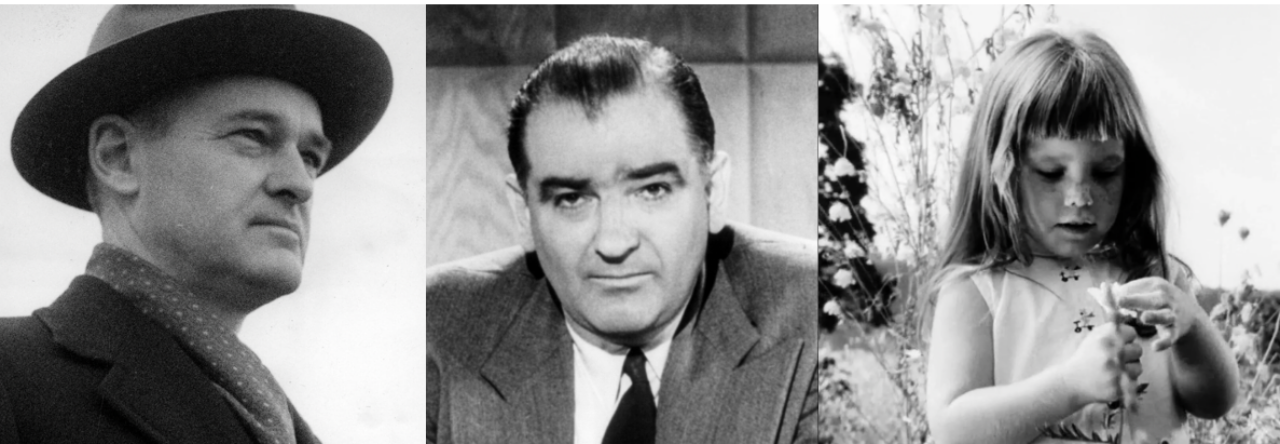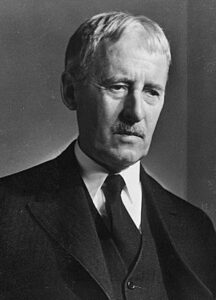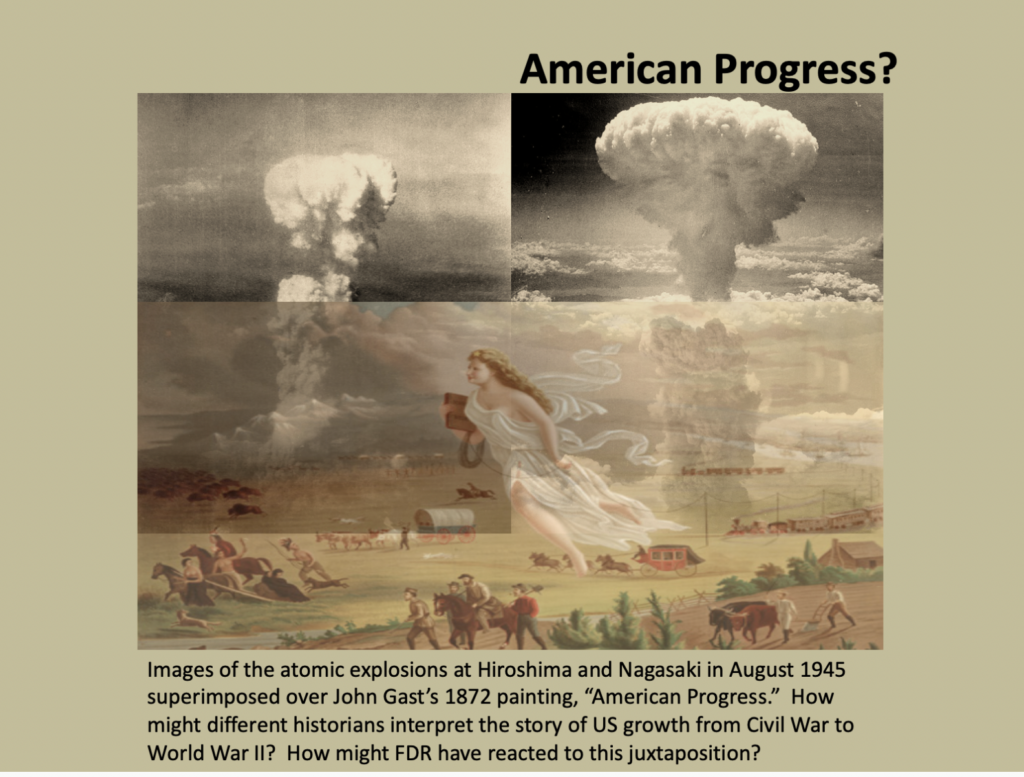How should Americans remember Hiroshima?
Thesis Framework
“How Americans came to understand their government’s decision to use atomic bombs against Hiroshima and Nagasaki is a classic case of a historical narrative shaped by government insiders to serve their view of the national interest. The controversy over the planned exhibition, centering on the Enola Gay (the plane that bombed Hiroshima), at the National Air and Space Museum (NASM) on the fiftieth anniversary of the end of World War II is a reminder that, even in the post-Cold War United States, history remains a hostage to politics, past and present.” –Martin Sherwin, “Hiroshima as Politics and History,” JAH (1995), p. 1085
Martin Sherwin, “Hiroshima as Politics and History”
Henry Stimson
“Henry L. Stimson, secretary of war from 1940 to 1945, was the most important formulator of the history of the atomic bombings of Hiroshima and Nagasaki; in modern political parlance, its chief “spin doctor.” Writing in 1947 to President Harry S. Truman, Stimson explained that his seminal article, ‘The Decision to Use the Atomic Bomb,’ was in part ‘intended to satisfy the doubts of that rather difficult class of the community which will have charge of the education of the next generation, namely educators and historians.’ To satisfy those potential doubters, Stimson explained that the Truman administration faced the choice of either using atomic bombs or invading Japan. The sole motivation for the atomic attacks, he wrote, was to save American lives by ending the war as quickly as possible. Missing was the idea, frequently discussed in his diary, that a dramatic wartime demonstration of the bomb would help control Joseph Stalin’s postwar ambitions. Nor did he discuss Japanese messages intercepted by United States military intelligence indicating that the Japanese had been trying to surrender ‘conditionally’ since June 1945. Assisted by the chilling effect that the Cold War had on debate and the long delay before the relevant documents became available to historians, Stimson achieved his goal.” –Sherwin, p. 1085
—Stimson, “Decision to Use the Atomic Bomb,” Harper’s (1947)
Cancelled 1995 Enola Gay exhibit at the Smithsonian
“I told the museum staff member who phoned me that I opposed calling celebratory attention to the Enola Gay on the fiftieth anniversary of its mission. Even if one believed that it had played a critical role in ending a terrible war, I opposed an exhibit that might be interpreted as celebrating the deaths of 150,000 to 200,000 Japanese civilians, mostly old men, women, and children.” –Sherwin, p. 1086
“John T. Correll, the editor of Air Force Magazine, had a decidedly different opinion of the exhibit. In his view, it not only suffered from too much of the PC, or political correctness, he disliked, but it was insufficiently endowed with the PC he exploited for his living, patriotic correctness. Correll considered the exhibit biased against the air force, pro-Japanese, and anti-American.” –Sherwin, p. 1089
Cold War and Remembering WWII
“The image of American moral superiority was promoted with special intensity during the Cold War, and our increasing reliance on nuclear deterrence created powerful resistance to criticism of the wartime use of nuclear weapons. Early questions about the need to destroy Hiroshima and Nagasaki were replaced with answers, such as Stimson’s article, and the answers given left no room for ambiguity.” –Sherwin, p. 1091
“The Cold War may have been a poor substitute for World War II, but World War II was an ideal model for the Cold War. The demand for clarity drove our politics. Stalin substituted for Adolf Hitler, communism replaced National Socialism, and Soviet cities were targeted as so many potential Hiroshimas and Nagasakis.” –Sherwin, p. 1092
Dropping of the Atomic Bomb (1945)
Atomic Age
Col. Paul Tibbets was the pilot in command of the Enola Gay (a B-29 bomber named for his mother) that dropped the atomic bomb on Hiroshima, Japan on August 6, 1945. The city had a population of about 350,000 at that time. The explosion immediately killed about 70,000 of those residents, destroying most of the city’s buildings. Tens of thousands more died in the weeks afterward. Tibbets was interviewed on camera, not long after he returned (August 19th).
Russell Baker was a young 19-year-old naval pilot originally from Virginia who was training to go overseas in the summer of 1945. He later became a Pulitzer Prize-winning columnist for the New York Times who recalled his coming of age during the Great Depression and World War II in a famous memoir, Growing Up (1982).
“On August 9 the second atomic bomb was dropped at Nagasaki. Next night I wrote to my mother. “Well, today, to all intents and purposes, the war ended. The feeling of extreme elation which I had expected, existed for a bare moment, then life subsided back into its groove and it was just another day….” I didn’t confess that I hated the war’s ending. I knew she had been praying to God to save my skin; I could hardly tell her I was sorry her prayers had been answered… Still there was no hint in either my mother’s correspondence or mine that the arrival of the nuclear age interested us much. My mother, also excited about premature news that the war was over, had less cosmic things on her mind. The night after the Nagasaki bombing she wrote: “I’m still hoping that you’ll go to college when the war is over and study journalism; that is, if you’re still interested in that kind of work. Don’t lose hope and get married at this stage of the game.” (Russell Baker, Growing Up, p. 230)
John Lewis Gaddis of Yale University is one of the nation’s leading historians of the Cold War era. In this excerpt, he challenges the widely-held view that President Harry S Truman never hesitated and never questioned his decision to authorize the dropping of two atomic bombs on the Japanese in 1945.
“It took leadership to make this [containment of atomic war] happen, and the most important first steps came from the only individual so far ever to have ordered that nuclear weapons be used to kill people. Harry S Truman claimed, for the rest of his life, to have lost no sleep over his decision, but his behavior suggests otherwise. On the day the bomb was first tested in the New Mexico desert he wrote a note to himself speculating that ‘machines are ahead of morals by some centuries, and when morals catch up perhaps there’ll be no reason for any of it.’ A year later he placed his concerns in a broader context: ‘[T]he human animal and his emotions change not much from age to age. He must change now or he faces absolute and complete destruction and maybe the insect age or an atmosphereless planet will succeed him.’ ‘It is a terrible thing,’ he told a group of advisors in 1948, ‘to order the use of something that …is so terribly destructive, destructive beyond anything we have ever had …. So we have got to treat this differently from rifles and cannon and ordinary things like that.’” (John Lewis Gaddis, The Cold War, p. 53)
Memory & Meaning
Behind-the-scenes with Christopher Nolan’s “Oppenheimer” movie (2023), based on the 2005 Pulitzer Prize-winning biography of physicist and Manhattan Project director J. Robert Oppenheimer by Kai Bird and Martin Sherwin



